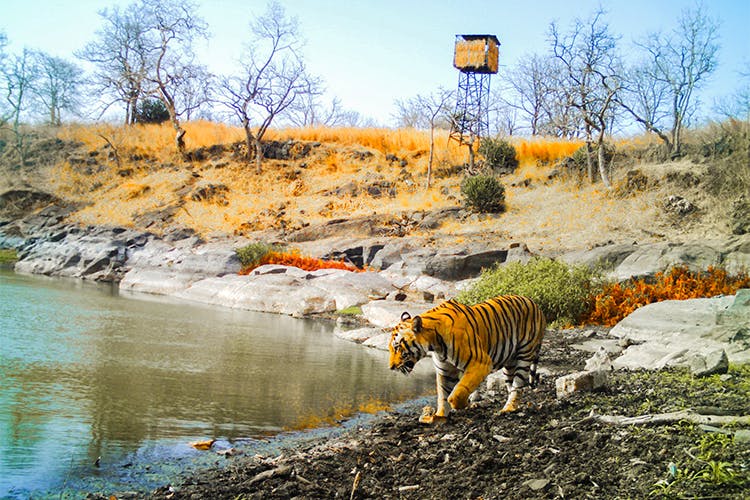The Maharashtra state’s Amaravati district is home to the Melghat Tiger Reserve. The Melghat Tiger Reserve is situated on Gavilgarh Hill, a southern branch of Central India’s Satpura Hill Range. West of Nagpur, it is 225 kilometres away. It was founded in 1967 as a wildlife sanctuary and designated as a tiger reserve in 1974. It was one of the original nine tiger reserves recognised in 1973–1974 as part of Project Tiger, an effort to conserve wildlife launched in India in 1972 with the goal of preserving Bengal tigers. It was Maharashtra’s first tiger reserve. In terms of acreage, it is still one of the largest tiger reserves in the nation. The term “Melghat” refers to the meeting of many “ghats” or valleys, which describes the characteristic topography of this tiger reserve.
Other notable animals, besides tigers, are sloth bears, Indian gaurs, sambar deer, leopards, nilgais, etc. Many sections of Melghat are home to the critically endangered Forest Owlet, which has made a comeback from extinction.
Melghat’s tourism is spread among 4 centers/villages. Harisal, Shahnur, Chikhaldara, and Semadoh. 14 kilometres in advance of Semadoh, at Kolkas, there are some extra lodging options. Our resort in Tadoba lies near Tadoba Andhari Tiger Reserve and is in close proximity to the Melghat Tiger Reserve as well. You can rejuvenate and relax at our resort in Tadoba while you can visit the tiger reserve during the daytime.

Image credits: ibb.in
Geography
The Melghat is located in the southwestern Satpura mountain ranges in the northernmost point of the Maharashtra district of Amravati, close to the Madhya Pradesh border. Melghat, “meeting of the ghats,” refers to the region as a sizable swath of endless hills and ravines pierced by sharp cliffs and challenging climbs. In 1974, the Melghat was designated as a tiger reserve. The reserve currently covers a total area of about 2768.52 km2. Teak trees predominate in the tropical dry deciduous forest (Tectona grandis). Five significant rivers that are tributaries of the river Tapti—the Khandu, Khapra, Sipna, Gadga, and Dolar—have their catchment areas in the reserve. This area is home to a wide variety of animals, including plants and fauna.
The tiger reserve is situated in the northern region of India’s Maharashtra State’s Amravati District, at coordinates 21°26′45′′N and 77°11′50′′E. The reserve’s boundaries are formed by the Tapti River and the Gawilgadh crest of the Satpura Range.
History
Being a pioneer comes naturally to the stunning surroundings of Melghat, which is tucked away in the Satpuda hill ranges of Central India created by Forsyth and Dunbar. The Indian government was shocked to discover barely 1800 tigers in a 1972 tiger census, compared to the 20000–40000 tigers estimated at the turn of the 20th century. This prompted the Indian government, led by Smt. Indira Gandhi at the time, established Project Tiger in 1973 to address the issue of tiger protection. In the country, nine tiger reserves were constructed in the first phase between 1973 and 1974. One of these nine tiger reserves, Melghat Tiger Reserve, was established on February 22nd, 1974. It initially covered 1571.74 square kilometres. This was the first tiger reserve in Maharashtra to be established; it was later expanded to 2029.04 sq. km. In the mysterious landscape of Melghat, there are vast tracts of unaltered natural forests made up of distinctive and representative ecosystems, rich in biodiversity, and offered in a variety of habitats by deep valleys (locally known as “khoras”) and high hills (locally known as “ballas”), deluged with rivers and “nallahs” that is perpetually wet in the “dohs.”
Melghat was one of the first nine tiger reserves to be notified as a tiger reserve in 1973–1974 as part of Project Tiger. Melghat Wildlife Sanctuary was established in 1985. The core part of the reserve, Gugamal National Park, has a 361.28 km2 area and was established in 1987.
Melghat contains passageways that northern invaders used to get to Berar, where the Imad Shahi dynasty was established in 1484. Historically, the main east-west ridge was protected by the forts of Narnala and Gawilgarh. The Gawilgarh fort was taken from the Marathas in 1803, during the Second Maratha War, by Colonel Arthur Wellesley, who would eventually become the Duke of Wellington.
How to reach the destination?
You can travel to Melghat by road, rail, and air (the nearest airport- is Nagpur). From a tourist’s perspective, Semadoh is the primary location. Another tourist destination in the Melghat Tiger Reserve is Narnala Sanctuary (base camp: Shahnur in the Akot district), where you may go on a jungle safari and see a fortification that dates back at least 600 years.
On Maharashtra State Highway No. 6, about 25 kilometres from Semadoh in the direction of Indore, is the digital village of Harisal.
In Maharashtra’s Vidarbha region, a popular tourist destination called Chikhaldara serves as another key entrance to the Melghat Tiger Reserve. It contains numerous privately owned hotels and resorts as well as the Vairat forest safari entrance.
By train: Take the Mumbai-Nagpur-Kolkata route and get off at Badnera Junction (10 km from Amravati) for Chikhaldara, Semadoh, Kolkas, and Harisal. For Narnala, get off the Mumbai-Nagpur-Kolkata route at the Akola Junction. Additionally, there are nearby locations from Betul on the Nagpur-Delhi route and Khandwa on the Mumbai-Bhopal line.
By Air: Daily flights connect Mumbai, Delhi, Kolkata, Bengaluru, Raipur, Indore, Pune, and other cities with Nagpur, which is the closest airport.
By Vehicle: There are many places in Melghat that can only be accessible by road.
Featured image credits: mandalnews.com



